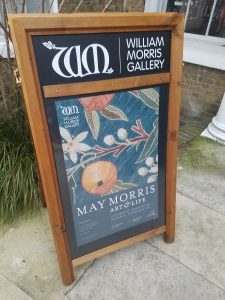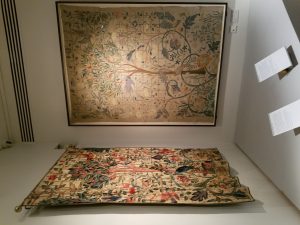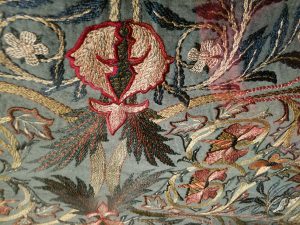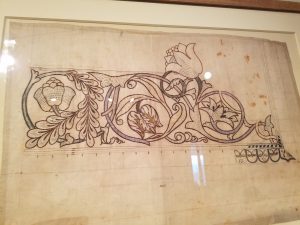May Morris and Intersectional Museum Exhibitions
Every January, the first-year fellows of the Winterthur Program and several students in MA and PhD programs from the University of Delaware take part in British Design History: a three-week course on design and material culture with one week at Winterthur and a two-week field study in Great Britain. Traveling to cities including London, Stoke-on-Trent, and Bath, the students have an opportunity to study American Material Culture within a greater global context. Students’ posts in this section are centered on their experiences in England or working with British objects in the Winterthur collection.
More and more these days, as scholars and human beings, we are rethinking and re-examining the historical stories with which we’ve become so familiar. We’re looking through the veil of the past and asking questions of intersectionality in our work and everyday lives. Fascinatingly, these questions are being asked by museums as well. As a result, new and exciting research, exhibitions, and re-attributions are being made and brought to the public, thus furthering debate and inquiry. The starting point for many of these bigger discussions in public history is highlighting and restoring lost narratives of women. One ideal example of this type of exhibition is May Morris: Art and Life at the William Morris Gallery in London, England.

Exhibition sign for May Morris: Art and Life at the William Morris Gallery in London. Photograph by the author.
Eleven other students and I recently had the privilege of taking in this thought-provoking exhibition on our intensive two-week study of British Design History this January in England. Using a vast group of embroideries and textile works, many never before on museum display, along with archival documents, photographs, jewelry, and more, curators crafted an exhibition that not only examined the life and art of May Morris but sought to place Morris in the larger context of the Arts and Crafts movement. The goal was to demonstrate her significance to the movement through both her own work and her lifelong support of her father, William Morris’s, legacy. Though previously acknowledged by some scholars, this history as well as May’s work has been mostly excluded from the story of the Arts and Crafts movement.

Two Tapestries of the same design but in different color ways made by May Morris. The tapestry on the left once hung in the Morris family home and was made for her father, William Morris. The other was created for another family and in colors to match their home. This is the first time these two pieces have been shown together. Photograph taken by the author.
In the exhibition as well as in the accompanying catalog of essays, May’s life and art is examined from different angles: as a daughter, a sister, an artist, a unrequited lover, a business woman, an educator, and a single woman of considerable wealth and power. The objects created by May in the exhibition – including tapestries for her family home, letters and sketches by May sent to lovers and friends, jewelry that she designed and made, and May’s hand-done pattern designs once thought to be the work of her father – are all put into conversation with one another to tell a deeper and more complex story than has previously been told. These items, in particular those that for years have been considered the sole creative genius of William Morris and are now correctly labeled as the work of his youngest daughter, guide the viewer to reconsider the history they “know.”
As a young museum professional and scholar, an exhibition like this gives me hope. William Morris has been a larger-than-life figure since his own time, and through her own work regarding her father’s legacy, as well as the work of others, May’s own story and significance was overshadowed. This has been the case time and time again for women in history. I hope that this new wave of restoring women’s narratives through museum exhibitions will pave the way for greater questions and deeper thinking regarding the intersectionality of museum exhibitions and historical figures.

A close up detailed photograph of an exemplary work by May Morris that highlights both her design aesthetic and her technical skill. May kept this in her home and personal collection for the majority of her life. Photograph taken by the author.
By Nora Ellen Carleson, Ph.D. Candidate, History of American Civilizations, University of Delaware


Leave a Reply